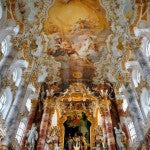The Baroque movement—enforced by the Catholic Church—reached its peak by the end of the 17th century. Yet there were a few people in France who thought that the system for Baroque architecture was too rigid.
They wanted more freedom. They wanted to incorporate elaborate and more flamboyant designs. Even church architecturehad to change.
Hence, the Rococo movement—also known as the late Baroque movement—was born.
The name Rococo comes from two words: The French word "rocaille" which means "stone" and the Italian word "barocco," a misshapen pearl. Interestingly, It was actually only coined during the 19th century and was not used during its conception.
And the Rococo movement fostered changes in Europe’s architecture.
Below are common features of Rococo architecture.
Walls
 Image source: V&A UK
Image source: V&A UK
Minimized was the use of entablatures and the designs have become more abstract. Plastic covers replaced the angles in the corners connecting to the ceiling.
Dado
 Image source: Rococo Revisited
Image source: Rococo Revisited
The dado or the lower part of the wall was dwarfed. During the period, it was also used to a lesser extent.
Ornaments and Decorations
 Image source: Wikipedia
Image source: Wikipedia
Elaborating on the abstract designs, incorporated were ornaments in shape of shells and plants. Scrollwork and bizarre designs were also used.
 Bizarre scrollwork found in Rococo structures.
Bizarre scrollwork found in Rococo structures.
Image source: JustAboveSunset.com
Color scheme
Rococo architecture used a lot of pastels. This was unlike the emphasis on light and dark lighting of the Baroque era upon neutral colors. Architects also used ivory white and gold.
Shapes
 mage source: AMT 200
mage source: AMT 200
Artists and architects deviated from the Baroque style through a complex approach. This made structures look more grandiose.
Examples of Rococo Architecture
Wies Church, Germany (circa 1740 AD)
 mage source: Wikipedia
mage source: Wikipedia
Asamkirche, Germany (1746 AD)
 Image source: City Scouter
Image source: City Scouter
Church of St. Theresa, Lithuania (mid 1700s AD)
 Image source: Vilnius Tourism
Image source: Vilnius Tourism
Through its flamboyant, over-the-top designs, Rococo architecture captivated many throughout the continent. Yet it was never embraced in places like the British Isles as they thought the style was too “French” for their taste.
It was also met with criticism. Figures like Voltaire stated that it was too trivial. Others said it catered to a worldly, more materialistic audience.
Religious leaders also remarked that the movement was too secular. It glorified political leaders instead of the divine. By that, there were only a few churches in France that adopted such style.
Rococo met its decline during the late 18th century as a new movement began to rise. This movement attempted once again to revive the artistic and architectural styles of the past.
This was the Neoclassical movement. It took inspiration from the Greco-Roman period. It replicated the art-forms and architecture of the ancient world.
We will talk about the Neoclassical movement in next week’s blog post.


